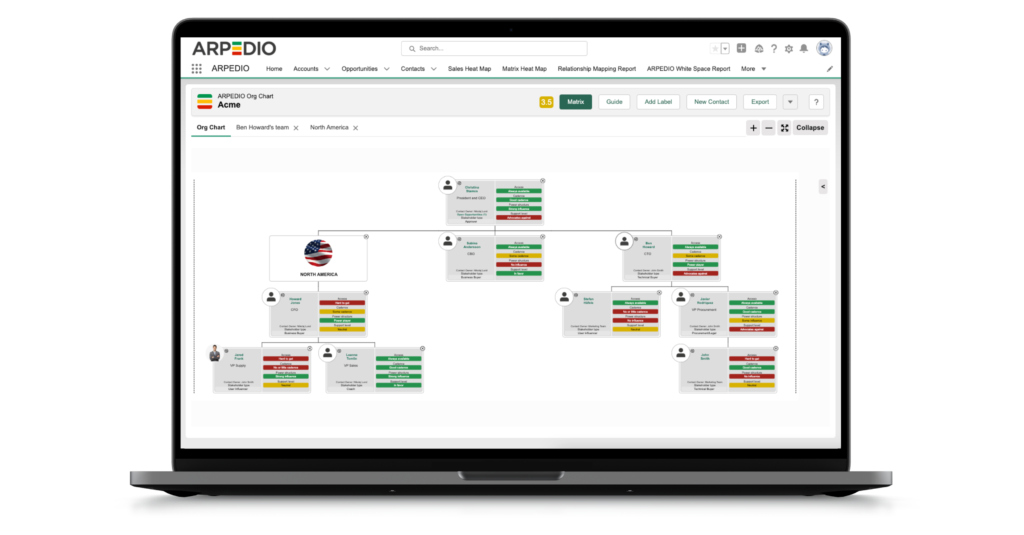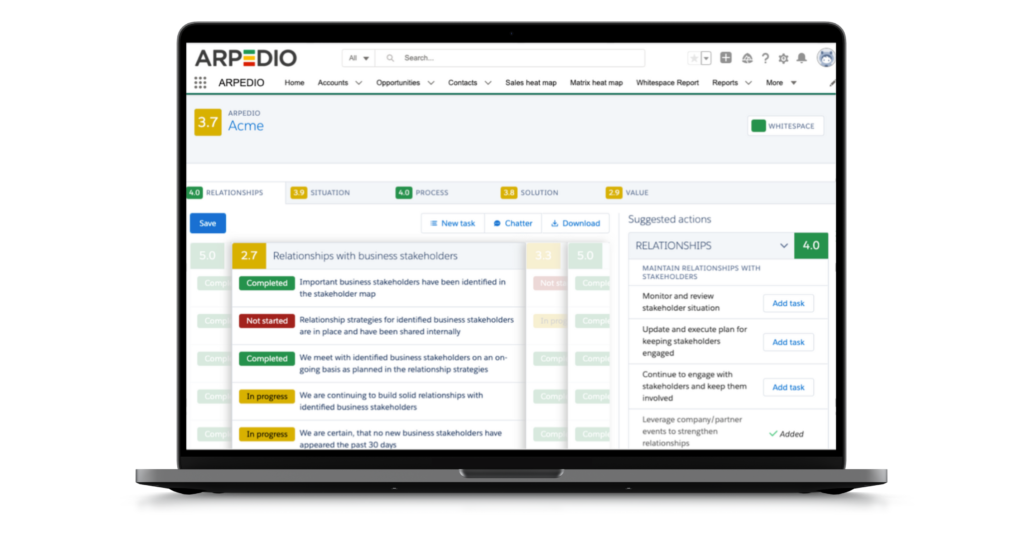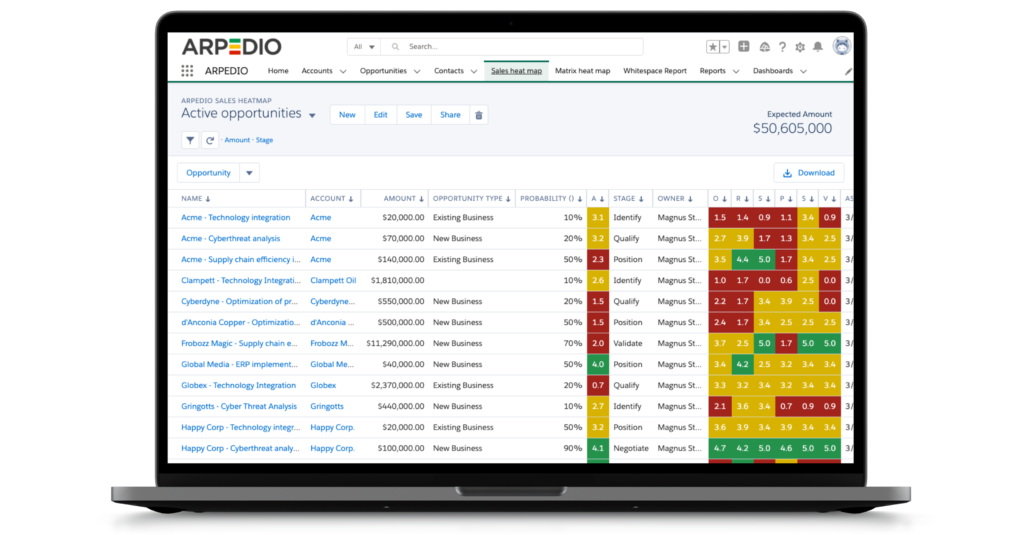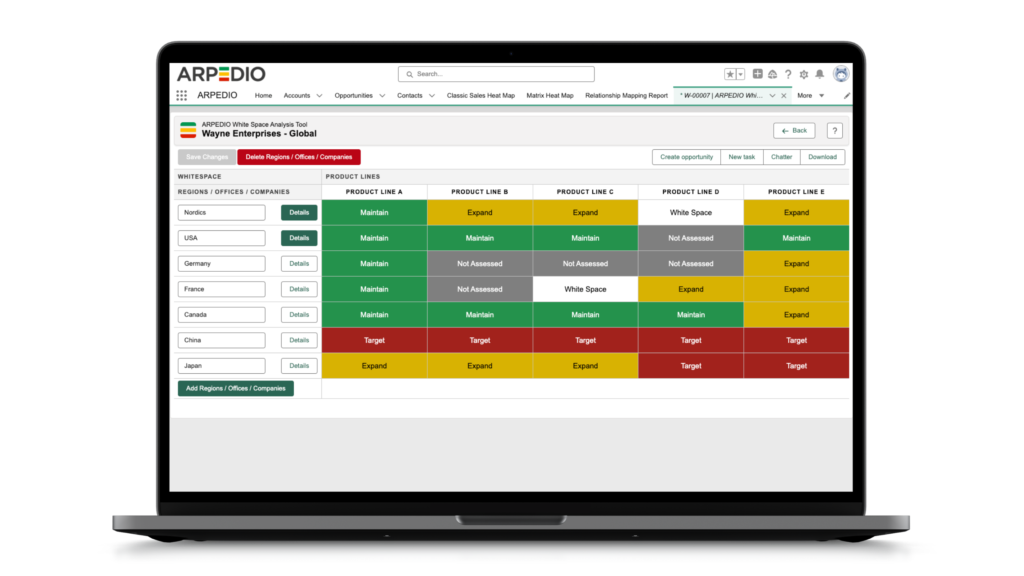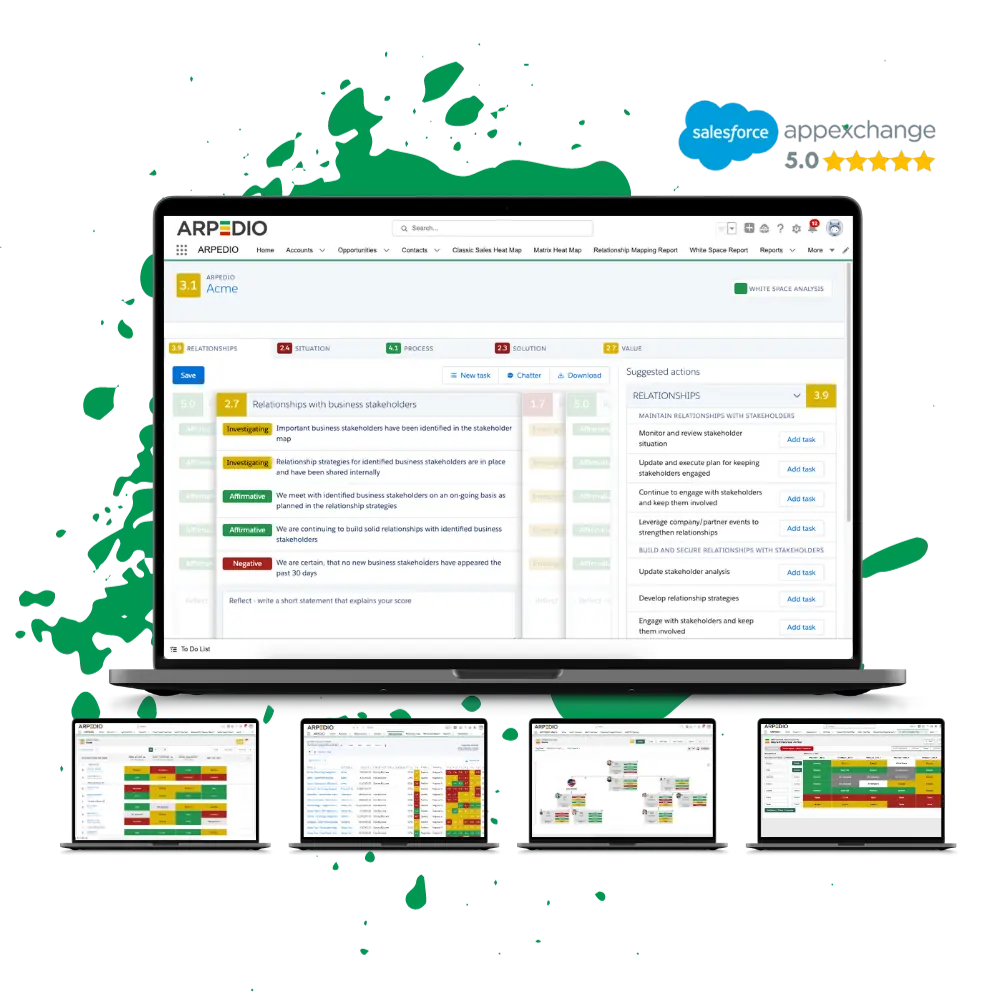Understanding the power of a stakeholder matrix – A comprehensive guide
In the dynamic landscape of account management, understanding your clients’ needs, expectations, and concerns is paramount to building lasting and mutually beneficial relationships. One invaluable tool that has gained prominence in the realm of account management is the stakeholder matrix.
Table of Contents
What is a stakeholder matrix?
A stakeholder matrix is a visual representation and organizational tool used to identify, categorize, and assess the significance of various stakeholders involved in a client’s organization or account. At its core, it serves as a structured framework that helps account managers and leadership gain insights into the complex web of individuals and groups impacting their client relationships.
By thoroughly analyzing stakeholders, organizations gain invaluable insights into who holds the power, who can impact decisions, and how to engage stakeholders strategically. These insights are crucial for informed decision-making, risk mitigation, and ensuring project alignment with broader organizational goals.
Why do you need a stakeholder matrix?
In account management, a stakeholder matrix is a valuable tool to help identify and categorize key individuals or groups within a client or customer organization who have a vested interest in the products or services being provided. Here are some reasons why a stakeholder matrix is essential:
1. Stakeholder identification and understanding
Account managers often work with diverse groups of stakeholders within their clients’ organizations. These stakeholders can range from key decision-makers to end-users and influencers. A stakeholder matrix provides a clear and organized view of who these individuals or groups are, what roles they play, and what their interests and priorities are.
2. Strategic engagement and enhanced prioritization
Effective account management involves tailoring communication and engagement strategies to suit the unique needs of different stakeholders. By categorizing stakeholders based on their influence, decision-making power, and level of engagement with your company, account managers can prioritize and allocate their resources and efforts strategically. This ensures that the most crucial stakeholders receive the attention they deserve.
Ready to increase customer lifetime value?
3. Risk Mitigation
In account management, unaddressed concerns or conflicts with stakeholders can jeopardize client relationships. A stakeholder matrix helps identify potential risks and conflicts early on, allowing account managers to proactively address issues and mitigate risks before they escalate.
4. Improved Decision-making and communication planning
Armed with a comprehensive view of stakeholders, account managers can make more informed decisions. They can align their account management strategies with the broader objectives and goals of the client organization, leading to more successful outcomes. This goes for the communication strategy as well: A stakeholder matrix can guide your communication strategy, ensuring that you tailor your interactions and messaging to meet the specific needs and preferences of each stakeholder group.
5. Client Satisfaction and relationship building
Ultimately, the use of a stakeholder matrix contributes to overall client satisfaction. When clients see that their needs and concerns are understood and addressed effectively, they are more likely to view their account manager as a trusted partner rather than just a service provider. This fosters positive and long-lasting relationships with clients and customers, which are crucial for long-term business success.
In summary, a stakeholder matrix is a fundamental tool that empowers account managers to navigate the complex landscape of client relationships with clarity and precision. It plays a pivotal role in understanding, engaging, and managing stakeholders, ultimately fostering stronger, more productive, and enduring account management partnerships.
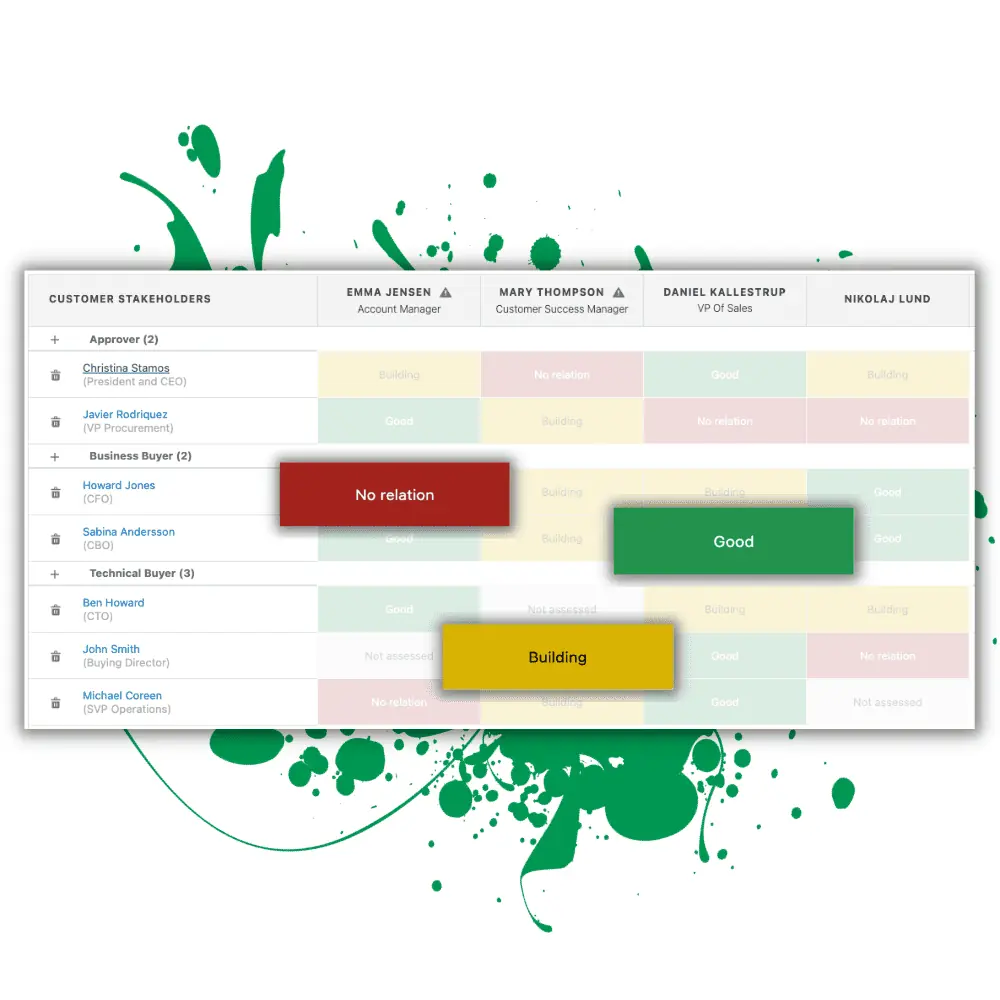
Key elements of a stakeholder matrix
A stakeholder matrix consists of four essential components that help account managers gain a comprehensive view of the stakeholders involved in a client’s organization or project. These key elements include stakeholder names, stakeholder roles, stakeholder interests, and stakeholder influence.
The first component involves listing the names of individuals or groups who have a stake in the project or account. Identifying stakeholders by name ensures that each relevant party is recognized and accounted for.
Understanding the roles and positions of stakeholders within the client’s organization is crucial. It provides insights into their responsibilities, decision-making authority, and how they fit into the overall structure.
Documenting the interests, objectives, or goals of each stakeholder helps account managers grasp what motivates them. This information allows for more targeted and meaningful interactions.
Assessing the level of influence or impact that each stakeholder wields is essential for prioritization. It helps determine which stakeholders have a more significant say in decisions and, consequently, require more attention and engagement.
These components collectively form the foundation of a stakeholder matrix, enabling account managers to organize information systematically, make informed decisions, and tailor their strategies to effectively manage client relationships.
How to create a stakeholder matrix in 10 steps
Creating a stakeholder matrix is a structured process that involves careful planning and organization. By following these step-by-step instructions, you can develop a comprehensive stakeholder matrix that will be instrumental in your account management efforts. Additionally, we’ll provide tips for effective stakeholder identification and categorization along the way.
Step 1: Define your project or account scope
Begin by clearly defining the scope of your project or account. Understanding the boundaries and objectives will help you identify the relevant stakeholders.
Step 2: Identify stakeholder categories
Categorize stakeholders into groups based on their roles and relationships with the project or account. Common categories include decision-makers, influencers, end-users, and support staff.
Step 3: Identify and list stakeholders
Within each category, list the specific individuals or groups who fall into those roles. This step requires thorough research and consultation with colleagues and team members who have insights into the client’s organization.
Step 4: Assess stakeholder interests and needs
For each stakeholder, assess their interests, needs, and concerns. Understand what motivates them and what they hope to achieve through the project or account. This information is crucial for tailoring your engagement strategies.
Step 5: Determine stakeholder influence
Evaluate the level of influence or power each stakeholder wields within the client organization. This assessment will help you prioritize your efforts and resources.
Step 6: Create the matrix
Now that you have all the necessary information, it’s time to construct the matrix. Create a table or spreadsheet with columns for stakeholder names, roles, interests, influence, and any additional relevant information.
Step 7: Populate the matrix
Fill in the matrix with the data you’ve collected for each stakeholder. Ensure that the information is accurate and up-to-date.
Step 8: prioritize stakeholders
Based on the assessment of influence and importance, prioritize your stakeholders. Identify high-priority stakeholders who require more focused attention and engagement.
Step 9: Develop engagement strategies
Using the stakeholder matrix as a guide, develop tailored communication and engagement strategies for each stakeholder group. Consider their interests, communication preferences, and specific needs.
Step 10: Regularly update and review
Stakeholder dynamics can change over time, so it’s crucial to regularly update and review your stakeholder matrix. This ensures that your strategies remain aligned with evolving stakeholder interests and influences.
Stakeholder Matrix best practices
When you set out to build your stakeholder matrix, don’t forget to involve colleagues and team members who possess insights into the client’s organization. Collaborative efforts can help ensure that you compile a comprehensive list of stakeholders. This collective approach enhances the accuracy and depth of your stakeholder matrix.
In the process of identifying stakeholders, adopt a meticulous approach. Leave no stone unturned, as even seemingly minor or indirect influencers can have a significant impact on the project or account. Thoroughness in stakeholder identification is crucial for capturing the full spectrum of individuals and groups with a stake in the endeavor.
Remember to maintain open lines of communication with stakeholders throughout the stakeholder identification and categorization process. Regular interaction allows you to verify and update stakeholder information as needed. Additionally, it fosters transparency and establishes a foundation of trust, which is invaluable for successful account management.
And finally, consider utilizing specialized software or templates designed for stakeholder analysis and matrix creation. These tools can streamline the process by providing a structured framework and automating certain aspects of data management. They help account managers efficiently compile, organize, and update stakeholder information, enhancing the overall effectiveness of the stakeholder matrix creation process.
By following these steps and adhering to the tips provided, you can create a robust stakeholder matrix that serves as a valuable resource for effective account management and relationship building.
Tools and templates for creating a stakeholder matrix
When it comes to crafting an effective stakeholder matrix for your account management needs, having the right tools, such as ARPEDIO, at your disposal can significantly streamline the process and boost your efficiency.
ARPEDIO’s Relationship Mapping solution offers a user-friendly template that can simplify the otherwise intricate process of stakeholder identification and categorization, offering benefits such as:
- Ease of use: ARPEDIO’s templates are designed with user-friendliness in mind, making it accessible for account managers of all levels of expertise.
- Structured framework: The templates provide a structured framework that guides you through the stakeholder matrix creation process, ensuring that you capture all the necessary details.
- Automation: Certain aspects of data management are automated, saving you time and effort in compiling, organizing, and updating stakeholder information.
- Customization: You can customize the templates to align with your specific project or account requirements, allowing for flexibility in usage.
Incorporating ARPEDIO’s Relationship Mapping solution into your account management toolkit can enhance your ability to create robust stakeholder matrices, ultimately contributing to more successful client relationships and business outcomes.
Interested in experiencing the benefits of ARPEDIO’s Relationship Mapping solution firsthand? Take it for a free test drive today!


